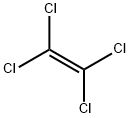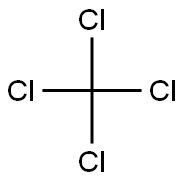Tetrachloroethylene , GR,99.5% , 127-18-4
Synonym(s):
Ethylene tetrachloride, Perchloroethylene, PCE;PCE;Perchloroethylene;Tetrachloroethylene
CAS NO.:127-18-4
Empirical Formula: C2Cl4
Molecular Weight: 165.83
MDL number: MFCD00000834
EINECS: 204-825-9
PRODUCT Properties
| Melting point: | -22 °C (lit.) |
| Boiling point: | 121 °C (lit.) |
| Density | 1.623 g/mL at 25 °C (lit.) |
| vapor density | 5.83 (vs air) |
| vapor pressure | 13 mm Hg ( 20 °C) |
| refractive index | n |
| Flash point: | 120-121°C |
| storage temp. | Store at +2°C to +25°C. |
| solubility | water: soluble0.15g/L at 25°C |
| form | Liquid |
| color | APHA: ≤10 |
| Odor | chloroform-like odor |
| Odor Threshold | 0.77ppm |
| Water Solubility | Miscible with alcohol, ether, chloroform, benzene and hexane. Slightly miscible with water. |
| FreezingPoint | -22.0℃ |
| λmax | λ: 290 nm Amax: 1.00 λ: 295 nm Amax: 0.30 λ: 300 nm Amax: ≤0.20 λ: 305 nm Amax: 0.10 λ: 350 nm Amax: 0.05 λ: 400 nm Amax: 0.03 |
| Merck | 14,9190 |
| BRN | 1361721 |
| Henry's Law Constant | 4.97 at 1.8 °C, 15.5 at 21.6 °C, 34.2 at 40.0 °C, 47.0 at 50 °C, 68.9 at 60 °C, 117.0 at 70 °C
(EPICS-GC, Shimotori and Arnold, 2003) |
| Exposure limits | TLV-TWA 50 ppm (~325 mg/m3) (ACGIH),
100 ppm (MSHA and OSHA); TLV-STEL
200 ppm (ACGIH); carcinogenicity: Animal
Limited Evidence. |
| Dielectric constant | 2.5(21℃) |
| Stability: | Stable. Incompatible with strong oxidizing agents, alkali metals, aluminium, strong bases. |
| LogP | 2.53 at 20℃ |
| CAS DataBase Reference | 127-18-4(CAS DataBase Reference) |
| IARC | 2A (Vol. Sup 7, 63, 106) 2014 |
| NIST Chemistry Reference | Tetrachloroethylene(127-18-4) |
| EPA Substance Registry System | Tetrachloroethylene (127-18-4) |
Description and Uses
Perchloroethylene (Tetrachloroethylene) is a colourless liquid with a slightly ethereal odour. It is marginally soluble in water and soluble in most organic solvents.Perchloroethylene has a limited number of uses and applications. It is used as intermediate, as dry cleaning agent in the industrial and professional sector, as surface cleaning agent in industrial settings, as heat transfer medium in industrial settings, and in film cleaning and copying by professionals. It is also used as a chemical intermediate in the production of fluorinated compounds and in industrial surface cleaning metal degreasing. Occupational exposure to perchloroethylene is possible in the manufacturing facilities or the industrial facilities where it is used as an intermediate.
Tetrachloroethylene is used as a solvent, indrycleaning, and in metal degreasing.Tetrachloroethylene is a common industrial solvent that is often found as a contaminant in groundwater. Tetrachloroethylene is also a suspected carcinogen to humans and is difficult to degrade biologically as it has no natural source. This compound is a contaminant of emerging concern (CECs).
Safety
| Symbol(GHS) |    GHS07,GHS08,GHS09 |
| Signal word | Warning |
| Hazard statements | H315-H317-H319-H336-H351-H411 |
| Precautionary statements | P201-P273-P280-P302+P352-P305+P351+P338-P308+P313 |
| Hazard Codes | Xn,N,T,F |
| Risk Statements | 40-51/53-23/25-11-39/23/24/25-23/24/25 |
| Safety Statements | 23-36/37-61-45-24-16-7 |
| RIDADR | UN 1897 6.1/PG 3 |
| WGK Germany | 3 |
| RTECS | KX3850000 |
| Autoignition Temperature | 260℃ |
| TSCA | Yes |
| HazardClass | 6.1 |
| PackingGroup | III |
| HS Code | 29032300 |
| Hazardous Substances Data | 127-18-4(Hazardous Substances Data) |
| Toxicity | LD50 orally in mice: 8.85 g/kg (Dybing); LC for mice in air: 5925 ppm (Lazarew) |
| IDLA | 150 ppm |



